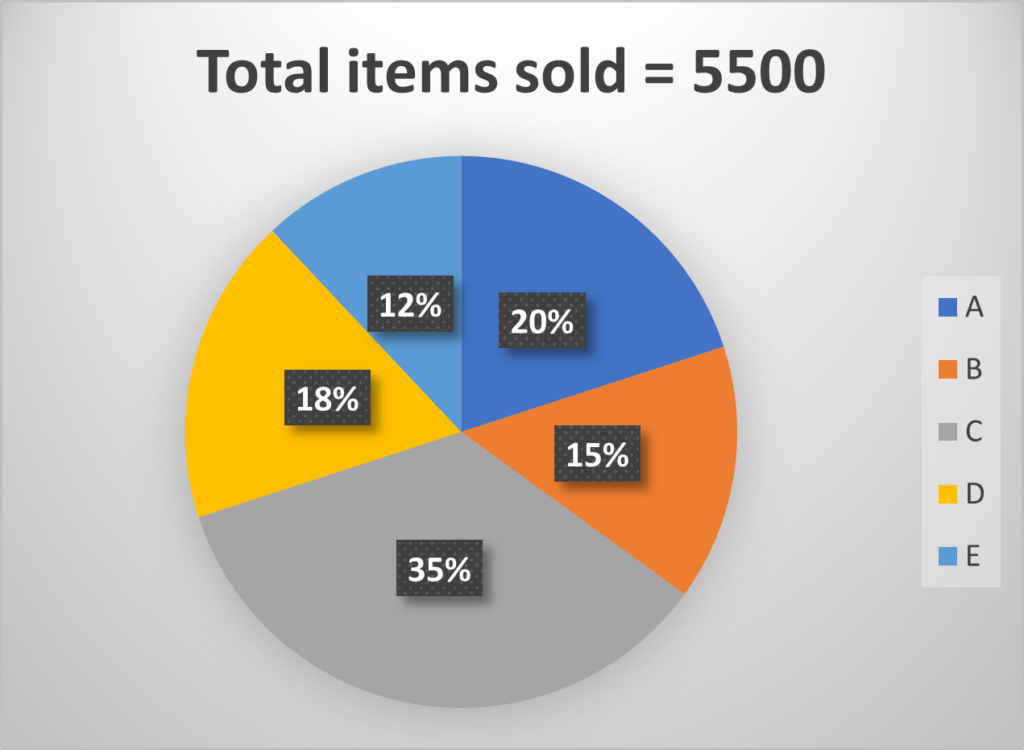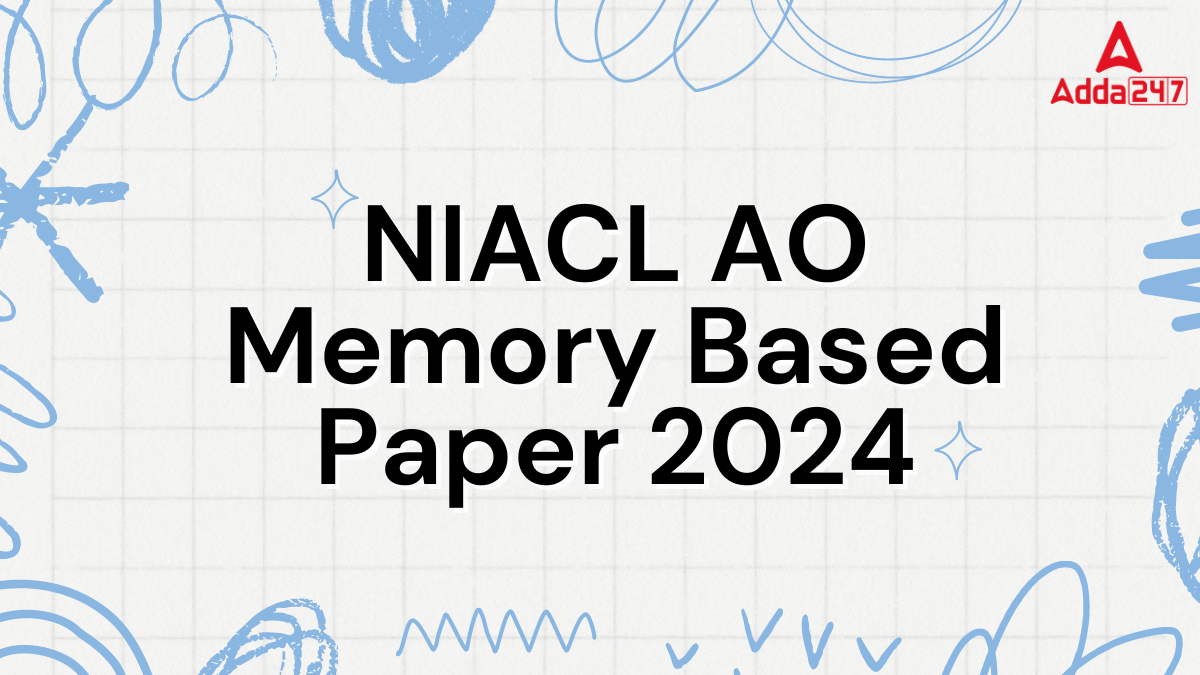Table of Contents
The NIACL AO Prelims Exam 2024, conducted on 13th October 2024, has now concluded in both shifts. Aspirants who appeared for the exam and those preparing for upcoming exams can benefit significantly from the memory-based questions that are created after the exam. These questions provide valuable insights into the type and difficulty level of the questions asked, helping candidates prepare better for future attempts.
NIACL AO Memory Based Paper 2024
Memory-based papers give a clear idea of how the exam was structured, including section-wise question distribution and commonly repeated topics. By practising these questions, candidates can sharpen their preparation for the upcoming NIACL AO Mains Exam 2024.
Candidates looking to get a detailed analysis and the complete set of memory-based questions can download the PDF. These papers are compiled from the feedback of candidates who appeared in both shifts of the exam. By reviewing these memory-based papers, candidates can improve their preparation strategies for future competitive exams.
NIACL AO Memory Based Paper 2024[Will Be Avilable Soon]
Some of the questions asked in the 13 October exam included the following:
Directions (1-2): In the questions given below, a sentence is divided into several parts. Select the most appropriate sequence to rearrange the parts into a grammatically correct and contextually coherent sentence.
Q1.
(A) large companies control most
(B) our country’s economy is a type of
(C) de facto monopoly in which a few
(D) of the wealth and power
(a) BACD
(b) CADB
(c) BCAD
(d) DCAB
(e) No rearrangement required
Q2.
(A) retinue of teachers
(B) school population, the district
(C) is seeking to increase its
(D) to support the growing
(a) DBCA
(b) BADC
(c) DCBA
(d) BACD
(e) No rearrangement required
Directions (3): There are three sentences given in each question. Find the sentence(s) which is/are grammatically incorrect and mark your answer choosing the best possible option among the five options given below each question. If all the sentences are incorrect, choose ‘None is correct’ as your answer.
Q3.
(I) The government announced new policies to reduce the budget deficit, which had widened due to increased public spending and lower tax revenues.
(II) The scientist conducted multiple experiments to showing the effectiveness of the newly developed vaccine in preventing the spread of the disease.
(III) The rapid advancement in technology have significantly transformed various industries, influencing the way businesses operate.
(a) Only (I)
(b) Only (III)
(c) Both (I) and (III)
(d) Both (II) and (III)
(e) None is correct
Directions (4): There are three sentences given in each question. Find the sentence(s) which is/are grammatically and contextually correct and mark your answer choosing the best possible option among the five options given below each question. If all the sentences are correct, choose ‘None is incorrect’ as your answer.
Q4.
(I) The artist skillfully blended vibrant colors and intricate patterns to create a mesmerizing mural that captivated everyone who passed by.”
(II) Visiting the ancient ruins of Machu Picchu has always been one of my biggest dream.
(III) He promised to complete the project by the end of the week, assuring everyone that no further delays would occur.
(a) Only (I)
(b) Only (III)
(c) Both (I) and (III)
(d) Both (II) and (III)
(e) None is incorrect
Directions (5): In the question below, a sentence has been given, a part of which is highlighted. Each sentence is followed by options which are possible substitutes to the highlighted part. Choose the option which acts as the correct substitute to make it correct grammatically and contextually.
Q5. Despite the challenging questions in the final round, none of the aspirant would give up easily, each determined to secure the coveted scholarship.
(a) no of the aspirants would
(b) none of the aspirants would
(c) none of the aspirants has
(d) none from the aspirants would
(e) No improvement needed
Directions (6-10): Read the following pie chart carefully and answer the questions given below. The pie chart shows the percentage distribution of total number of items sold by five shops.

Q6. Find the difference between the total items sold by A and E.
(a) 450
(b) 440
(c) 480
(d) 550
(e) 520
Q7. If total unsold items by A is 20% of the total items sold by C, then find the total items manufactured (sold and unsold) by A.
(a) 1485
(b) 1785
(c) 1945
(d) 1135
(e) 1255
Q8. The total items unsold by F is the average of the total items sold by D and E. If the total items manufactured (sold and unsold) by F is 25% more than the total items sold by A, then find the difference between the total items sold by C and F.
(a) 1935
(b) 1185
(c) 1245
(d) 1375
(e) 1090
Q9. If 60% of the total items manufactured by B are sold, then find the total unsold items by B.
(a) 110
(b) 440
(c) 550
(d) 330
(e) 660
Q10. Find the ratio of the total items sold by C to the total items sold by A and B together.
(a) 2:1
(b) 1:2
(c) 1:1
(d) 1:4
(e) 4:1
Directions (11-15): Read the following table carefully and answer the questions given below. The table shows the total number of calculators and laptops sold together by five different companies. The table also shows the total number of calculators sold by these five companies.
| Companies | Total number of calculators and laptops sold | Total number of calculators sold |
| A | 440 | 320 |
| B | 560 | 300 |
| C | 350 | 270 |
| D | 800 | 450 |
| E | 950 | 560 |
Q11. Find the difference between the total number of laptops sold by D and the total number of calculators sold by C.
(a) 40
(b) 90
(c) 60
(d) 50
(e) 80
Q12. The total number of laptops sold by A is what percentage more or less than the total number of calculators sold by B?
(a) 60%
(b) 45%
(c) 35%
(d) 30%
(e) 50%
Q13. Find the average number of laptops sold by all five companies.
(a) 180
(b) 360
(c) 120
(d) 240
(e) 200
Q14. If the price of each laptop and each calculator sold by B is Rs 15000 and Rs 200, respectively, then find the total revenue generated by B.
(a) Rs 3960000
(b) Rs 1285000
(c) Rs 3245000
(d) Rs 456500
(e) Rs 123450
Q15. Find the ratio of the total laptops sold by C to the total calculators sold by E.
(a) 1:9
(b) 1:7
(c) 2:3
(d) 4:9
(e) 4:1
Directions (16-20): Study the information carefully and answer the questions given below.
Eight persons P, Q, R, S, T, U, V, and W are living in a four-story building where the ground floor is numbered as 1, the floor above it is numbered as 2, and so on, until the topmost floor, which is numbered as 4. Each floor has two flats, namely flat-1 and flat-2. Flat-1 of floor-2 is immediately above flat-1 of floor-1 and immediately below flat-1 of floor-3, and so on. Similarly, flat-2 of floor-2 is immediately above flat-2 of floor-1 and immediately below flat-2 of floor-3. Flat-1 is situated to the west of flat-2.
There is a two-floor gap between Q and T, but they do not live in the same numbered flat. S lives on an odd-numbered floor in the flat to the east of T’s flat. W lives on an even-numbered floor in the flat to the west of R. V lives above R but not in the same numbered flat, but there is a one-floor gap between them. U and V do not live in the same numbered floor.
Q16. Who among the following lives in flat-1 of the 4th floor?
(a) P
(b) Q
(c) S
(d) V
(e) None of these
Q17. Who among the following is/are living with T in the same numbered flat?
(a) V
(b) S
(c) R
(d) W
(e) Both (a) and (d)
Q18. Which among the following combination is/are true?
(a) U – Flat 1
(b) W – Floor 4
(c) P – Flat 1
(d) S – Floor 2
(e) All are true
Q19. How many floors are there between U and S?
(a) Both are living on the same floor
(b) None
(c) Two
(d) One
(e) Can’t be determined
Q20. The number of floors gap between T and U is the same as the number of floors gap between ____ and _____.
(a) Q – V
(b) P – S
(c) W – R
(d) T – R
(e) None of these
Q21. In the word ‘REVOLT’, how many pairs of the letters have the same number of letters between them (both forward and backward direction) in the word as in the alphabet?
(a) Four
(b) Two
(c) One
(d) Three
(e) More than four
Q22. Find Odd one out?
(a) EGV
(b) DFW
(c) CXZ
(d) XZC
(e) LNO
Direction (23-25): Study the following information to answer the given questions:
Point G is 10m north of point A. Point B is 10m east of point A. Point C is 20m south of point B. Point D is 10m west of point C. Point E is 10m north of point D. Point F is 15m west of point E. Point H is 15m north of point F. Point K is 5m east of point H.
Q23. In which direction is point K with respect to point G?
(a) South-west
(b) North-east
(c) North-west
(d) South-east
(e) None of these
Q24. If point Z is 10m east of point K, then what is the shortest distance between point A and point Z?
(a) 10m
(b) 5m
(c) 15m
(d) 20m
(e) None of these
Q25. If point J is exactly midpoint of BC then what is the shortest distance between point E and point J?
(a) 10m
(b) 5m
(c) 15m
(d) 20m
(e) None of these
Why Use NIACL AO Memory-Based Papers?
- Understanding the Exam Pattern: It helps candidates get familiar with the type of questions asked in different sections of the exam.
- Improving Accuracy and Speed: By solving these papers, candidates can enhance their speed and accuracy for the actual exam.
- Identifying Important Topics: Candidates can recognize recurring topics, which allows them to focus more on essential areas for the upcoming exams.





 GA Capsule for SBI Clerk Mains 2025, Dow...
GA Capsule for SBI Clerk Mains 2025, Dow...
 The Hindu Review October 2022: Download ...
The Hindu Review October 2022: Download ...
 Rajasthan Gramin Bank Formed after Merge...
Rajasthan Gramin Bank Formed after Merge...


